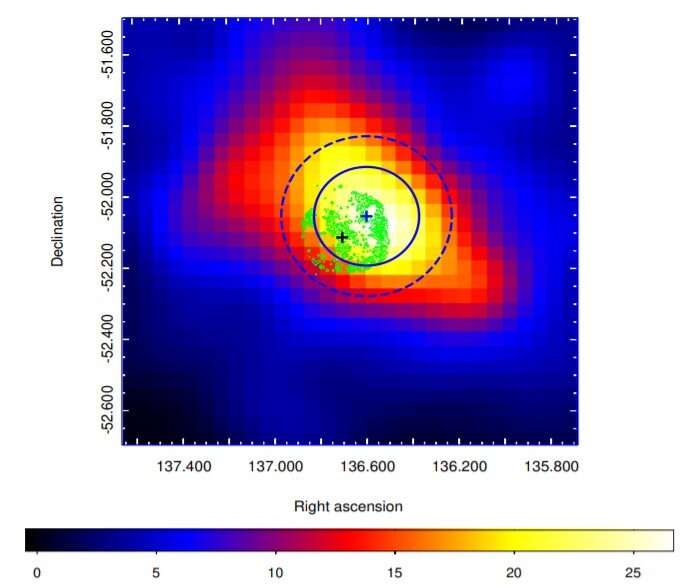April 6, 2021 report
Gamma-ray emission detected from the supernova remnant G272.2-3.2

Using NASA's Fermi Gamma-ray Space Telescope, Chinese astronomers have detected significant GeV gamma-ray emission from a supernova remnant (SNR) known as G272.2-3.2. The finding is detailed in a paper published March 29 on the arXiv pre-print repository.
SNRs are diffuse, expanding structures resulting from a supernova explosion. They contain ejected material expanding from the explosion and other interstellar material that has been swept up by the passage of the shockwave from the exploded star.
Studies of supernova remnants are important for astronomers, as they play a key role in the evolution of galaxies, dispersing the heavy elements made in the supernova explosion into the interstellar medium (ISM) and providing the energy needed for heating up the ISM. SNRs are also believed to be responsible for the acceleration of galactic cosmic rays.
G272.2-3.2 is a type Ia SNR detected in 1994 by the ROSAT X-ray satellite. Observations of this source revealed that it is a thermal composite SNR because of its thermal emission and non-shell-like morphology features. The distance to the object is estimated to be most likely 6,500 light years.
To date, no significant gamma-ray emission has been detected from G272.2-3.2. Astronomers Yun-Chuan Xiang and Ze-Jun Jiang of the Yunnan University in China have recently conducted a search for such emission which brought promising results.
"Through our preliminary analysis, we found a likely GeV gamma-ray radiation in the region of SNR G272.2-3.2 by checking test statistic (TS) maps, inspiring us to further explore its relative features in the GeV energy band," the astronomers wrote in the paper.
By analyzing the data from more than 12 years of observations with Fermi, the researchers identified a significant gamma-ray emission from G272.2-3.2 in the 0.2-500 GeV energy band. The magnitude of the source's GeV emission was found to be consistent with that reported in other thermal composite SNRs in our galaxy.
Furthermore, the GeV spatial position of G272.2-3.2 coincides well with that of the X-ray band from ESA's XMM-Newton spacecraft. No significant variability of this source was detected by analyzing its light curve. The newly found gamma-ray source appears to have a soft spectrum with a spectral index of approximately 2.56.
The obtained results allowed Xiang and Jiang to assume that the identified gamma-ray emission originates from SNR G272.2-3.2.
"A significant gamma-ray new source with approximately 5σ significance level is found from the region of SNR G272.2-3.2; its gamma-ray spatial distribution does not exist extended feature; it has a soft spectrum with a spectral index of 2.56±0.01; no significant variability of its LC [light curve] is found; its spatial positions in the X-ray and GeV bands well overlap. We suggest that the new gamma-ray source is likely to be a counterpart of SNR G272.2-3.2," the authors of the paper concluded.
More information: Fermi-LAT detection of the GeV gamma-ray emission from Type Ia SNR G272.2-3.2, arXiv:2103.15384 [astro-ph.HE] arxiv.org/abs/2103.15384
© 2021 Science X Network



















